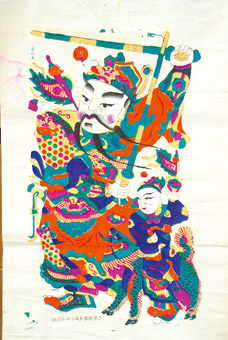Folk art dying out as old masters pass away
Folk arts are dying off along with their practitioners
"Are you familiar with Tantou Spring Festival pictures? I fear they are going to disappear after the last old master Mr. Zhong Haixian passed away earlier this year. How to save grassroots folk art is a real problem," said Zeng Qinglin a folk art enthusiast who runs an intellectual property consulting firm in Changsha, the capital of Hunan Province.
 |
|
Zhong Haixian makes a Tantou Spring Festival Picture. [hnwhyc.com] |
Zeng recently proposed the Hunan government introduce new laws to protect the province's disappearing folk arts and crafts.
Qin Baolai, a former curator of the Shaoyang City's Mass Art Hall in Hunan, is another enthusiast. He has been traveling around the Shaoyang area for the last 20 years collecting folk art. He explains that the Tantou Spring Festival Pictures are the only surviving examples of handmade wood-block printing in Hunan. Their unique style dates back to the early Qing Dynasty. The pictures are very colorful and the characters are drawn in a bold, primitive style. The finished product looks almost like a bas-relief. Creating a Tantou picture involves more than 20 separate steps, including making the paper, cutting the wood blocks, seven stages of printing, and seven stages of hand drawing.
There are three main types of Tantou pictures - portraits of gods, auspicious symbols and scenes from traditional operas - and around 40 common themes, with titles like "The Rats' Wedding," "The Door God Qin Shubao" and "Harmony Leads to Happiness." The pictures recall episodes in Chinese history and reflect many aspects of traditional culture.
But the art of making Tantou pictures is dying out. One reason is that less and less people paste pictures on their doors to celebrate Chinese New Year. After Zhong Haixian passed away the only person left who can make the pictures in the traditional way is his wife, Gao Lamei.
Qin Baolai said that in the 1980s there were 366 folk artists registered in Shaoyang, practicing 100 separate art forms. By 2002 only 57 artists and 26 folk art forms could be found. In 2004 alone, 7 types of folk art completely disappeared as the old masters passed away.
The government must change its attitude to folk art
"Central and local governments have policies to protect the cultural heritage, but they are not given sufficient priority or attention." Qin said.
|
|
|
"Door God Qin Shubao" [chinanews.com] |
To raise government officials' awareness of folk art, Qin mounted a campaign 6 years ago. During Spring Festival in 2003, he took 11 local folk artists to perform in front of city leaders. They were so impressed with the artists' skills and also saw an opportunity to make money. As a result of Qin's campaign the government voted to give 500 yuan (US$73) a month to 8 elderly artists to finance the training of apprentices.
"Most folk arts are passed on by word of mouth. There are no written records. The embroidery of the Yao people is an example. A Yao girl usually begins learning how to stitching at the age of 7. She is usually illiterate. The patterns she creates are learned from her mother. The blueprints are in their minds. The social and cultural environment is the key. Every Yao woman learnt how to stitch in the past. But now many of them leave home to seek work elsewhere. No one teaches their children now. "Qin said.
Shaoyang city has proposed dozens of non-material cultural heritage protection projects to the central government in recent years. The local Culture Bureau has established a cultural protection center. But has been starved of funds and staff and its current budget available for protection projects is just 30,000 yuan (US$4393).
"We have asked government departments for more money several times. But the officials say there are no explicit laws on heritage protection, so they can't authorize the funds. "Qin said. He says government officials pay too much attention to seeking prestigious world heritage status while local folk arts die out under their noses.
Folk art protection needs laws.
"Folk art cannot be protected by a few government departments or individuals. We need specific protection laws. Tantou pictures are a symbol of the disappearance of folk arts across the country," said Zeng Qinglin.
Zeng submitted his proposal in response to an appeal for 2010 legislative proposals from the Hunan government. Zeng believes the government can contribute a great deal by, for example, granting certificates to folk artists, which confer both recognition and a responsibility toward their craft. The government should also support artists with grants, preferential commercial policies and tax relief, said Zeng.
Qin said local governments should set up special funds to support the apprentices of important folk artists. "The non-material cultural heritage is passed on by word of mouth, so nurturing the talents of apprentices is vital. It is people above all, we need to protect."
Local governments used to promote folk art to attract tourists. But the art lost its original flavor due to over-marketing and over-exploitation. "We also need to guard against the overdevelopment of folk arts." Qin said. "This kind of ‘protection' is actually a form of abuse. It should be prohibited by law."
(This article was translated by Ren Zhongxi.)
 0 Comments
0 Comments







